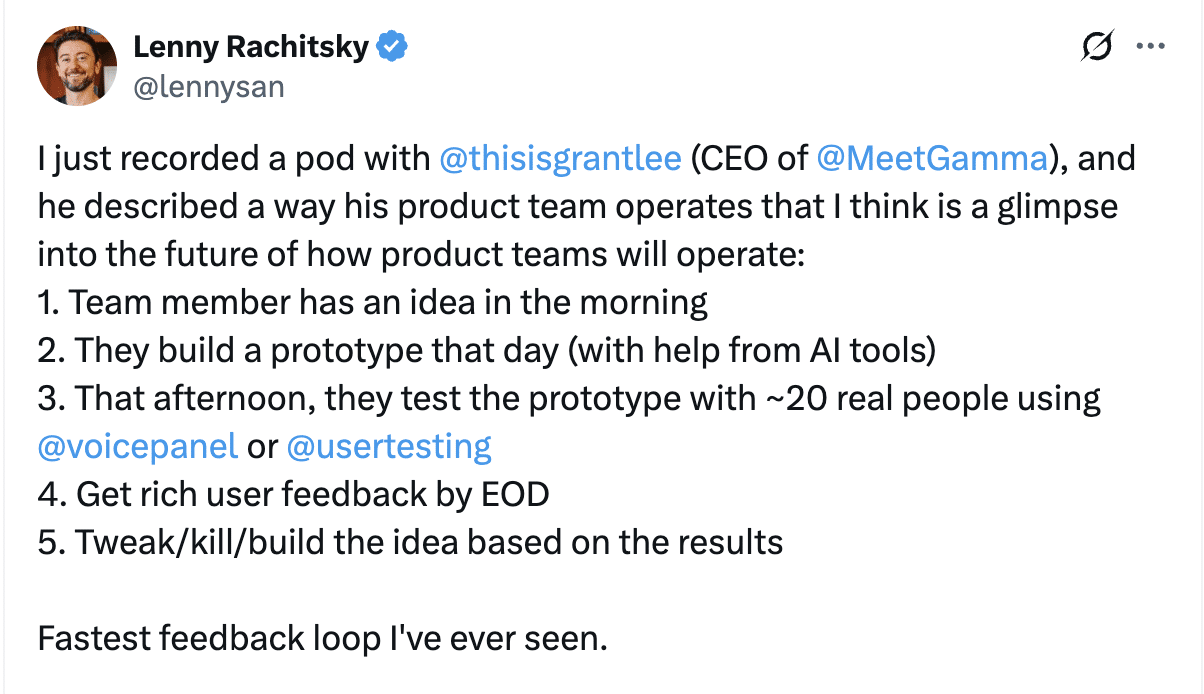En tant qu'investisseurs SaaS de longue date, nous sommes fascinés par la façon dont l'IA remodèle le cycle de développement des logiciels. Les équipes construisent et livrent à un rythme qui était impensable il y a un an - et au centre de ce changement se trouve la gestion des produits.
La vitesse d'exécution n'a jamais été aussi élevée, mais l'art de bien construire est en train d'être réécrit en temps réel. Au début du mois, lors dudîner Battery's Future of Product, nous avons réuni une douzaine de chefs de produit pour discuter de l'évolution du rôle du chef de produit dans les startups et les entreprises. Vous trouverez ci-dessous sept changements qui sont apparus :
1. D'une culture du produit axée sur la rédaction à une culture du produit axée sur la construction
De nombreux grands opérateurs historiques tentent de désapprendre leurs cultures traditionnelles "à forte intensité rédactionnelle", fondées sur des DRP et des rituels structurés. Pour avancer à la vitesse d'une startup, ils adoptent une culture où l'on construit d'abord, où l'on montre et où l'on ne dit pas. On attend désormais des gestionnaires de projets qu'ils prototypent, valident et itèrent les idées à l'aide d'outils tels que V0, Lovable, Cursor - et non qu'ils se contentent de rédiger des documents.

Grant Lee, PDGde Gamma, a récemment partagé avec Lenny's Podcast un aperçudu fonctionnement de son équipe de produits. Ce qui nécessitait autrefois des semaines de planification peut désormais se faire avant le déjeuner. Ce rythme change tout dans le fonctionnement des PM.
2. L'ingénierie n'est plus le goulot d'étranglement
Pendant des années, la largeur de bande de l'ingénierie a été le facteur limitant de la vitesse des produits. Avec les outils de codage assistés par l'IA, ce goulot d'étranglement s'est déplacé pour faire apparaître un nouveau goulot : la clarté. Les ingénieurs peuvent désormais créer et livrer des fonctionnalités plus rapidement que les gestionnaires de projet ne peuvent le planifier et, dans certains cas, plus rapidement que les utilisateurs ne peuvent l'absorber.
Comme l'a fait remarquer un chef de produit, les clients leur demandent maintenant de ralentir le lancement des fonctionnalités, frustrés par le fait que l'interface utilisateur semble changer toutes les semaines. Aujourd'hui, le plus grand risque pour les équipes produit n'est pas d'avancer trop lentement, mais d'avancer rapidement dans la mauvaise direction.
3. Tout le monde est un créateur de produits
Dylan Field, PDG de Figma, a récemment déclaré: "Nous sommes tous des créateurs de produits, et certains d'entre nous sont spécialisés dans leur domaine particulier". Avec le chevauchement des rôles, les frontières traditionnelles entre l'ingénierie, la conception et le produit (EPD) s'estompent. Les gestionnaires de projets conçoivent et réalisent des prototypes de manière indépendante ; les concepteurs réfléchissent plus profondément à ce qu'il faut construire et pourquoi ; et les ingénieurs s'engagent directement dans la découverte et la validation de l'utilisateur. À bien des égards, le design est devenu le tissu conjonctif qui transforme la vitesse en cohérence.
4. La stratégie produit s'étend au-delà de la construction
Les startups spécialisées dans l'IA ont plus que jamais du mal à se démarquer de la masse d'idées reçues. La différenciation devenant de plus en plus difficile, les responsables de projets sont amenés à s'intéresser de plus près à la tarification, à l'emballage et au positionnement, domaines traditionnellement dévolus aux équipes chargées de la commercialisation.
Étant donné leur proximité avec la valeur client, la conception du flux de travail et les résultats pour l'utilisateur, les GP disposent souvent du meilleur contexte pour décider du prix d'un produit, de la manière dont la valeur doit être communiquée et de ce que les utilisateurs paieront réellement. Dans de nombreuses entreprises natives de l'IA, comme Unify*, le marketing produit est désormais directement rattaché au produit, ce qui montre à quel point la stratégie produit et la narration sont étroitement liées.
5. Les FDE et les agents PM transforment l'IA en ROI
L'un des développements les plus intéressants qui ont fait surface est la façon dont les startups aident réellement les entreprises à construire avec l'IA.
Dans cette vague d'IA, tout le monde, des startups aux grandes entreprises, est un adopteur précoce. De nombreuses grandes entreprises ont mis en place des "centres d'excellence" en matière d'IA afin de définir et de hiérarchiser les cas d'utilisation, mais elles manquent souvent de la profondeur technique nécessaire pour créer et déployer des applications agentiques.
Cette lacune a conduit à l'essor des modèles FDE (Forward Deployed Engineer) et Agent PM, dans lesquels des startups comme Ramp intègrent des pods dédiés au sein des entreprises clientes pour faire passer un cas d'utilisation de la définition au prototype, puis à la production et au retour sur investissement. Il s'agit d'une approche à forte intensité de services, mais axée sur le retour sur investissement, qui permet d'obtenir rapidement des résultats tangibles. Au fil du temps, ces partenariats devraient évoluer vers des modèles plus productifs, en libre-service, au fur et à mesure que la maturité des entreprises augmente.
6. Redéfinir les indicateurs de succès des produits pour les applications agentiques
Les mesures traditionnelles telles que DAU, MAU et temps de session ont été conçues pour des produits basés sur l'interface utilisateur, mais les applications agentiques n'ont souvent pas d'interface utilisateur et visent à effectuer le travail de manière autonome. Le succès s'oriente vers des mesures basées sur les résultats, telles que les taux d'achèvement des flux de travail ou la précision de l'automatisation. En bref, le "temps passé" cède la place au "travail effectué", ce qui marque un changement fondamental dans la manière de définir le succès d'un produit et la valeur pour l'utilisateur.
Un responsable de produit a noté qu'après le lancement des agents d'intelligence artificielle, le nombre total d'utilisateurs actifs hebdomadaires a diminué, mais que l'engagement des utilisateurs expérimentés a augmenté. Ces utilisateurs puissants sont souvent des administrateurs qui se connectent fréquemment pour affiner les configurations, auditer les journaux des agents et créer de nouveaux flux de travail.
7. Les évaluations de l'IA font de plus en plus partie de la discipline de la gestion des ressources humaines
Les systèmes d'IA étant intrinsèquement non déterministes, les évaluations - qui relevaient autrefois de l'ingénierie - font désormais partie intégrante du rôle du gestionnaire de projet. Les gestionnaires de projets conçoivent des cadres d'évaluation qui mesurent la performance des modèles ou des agents par rapport aux objectifs de l'entreprise, en fixant des seuils de précision, de fiabilité et de qualité.
Cette capacité d'"évaluation de l'IA" est en train de devenir un nouveau pilier du métier de gestionnaire de projet - un pilier qui combine l'expérimentation, l'analyse et le jugement du produit pour s'assurer que le comportement du modèle s'aligne sur les résultats escomptés.
La prochaine frontière de la gestion des produits
Alors que l'IA accélère chaque partie du cycle de développement de Logiciel, les rôles convergent au service d'un objectif commun : construire des produits qui fonctionnent vraiment pour les utilisateurs. Les chefs de projet qui réussiront dans cette nouvelle ère ne mesureront pas leur impact en fonction des fonctionnalités expédiées ou des problèmes résolus, mais en fonction de la clarté, de la cohérence et du goût qu'ils apportent à ce qui est construit - et à ce qui est laissé de côté.
Les informations contenues dans ce commentaire de marché sont basées uniquement sur les opinions de Sudheendra Chilappagari, Neeraj Agrawal et Jenny Kang, et rien ne doit être interprété comme un conseil d'Investissements. Ce matériel est fourni à titre d'information et ne constitue en aucun cas un conseil juridique, fiscal ou en matière d'investissement, ni une offre de vente ou une sollicitation d'une offre d'achat d'une participation dans un fonds ou un véhicule d'investissement géré par Battery Ventures ou toute autre entité Battery. Les opinions exprimées ici sont uniquement celles des auteurs.
Les informations ci-dessus peuvent contenir des projections ou d'autres déclarations prospectives concernant des événements ou des attentes futurs. Les prévisions, opinions et autres informations présentées dans cette publication sont susceptibles d'être modifiées en permanence et sans préavis d'aucune sorte, et peuvent ne plus être valables après la date indiquée. Battery Ventures n'assume aucune obligation et ne s'engage pas à mettre à jour les déclarations prévisionnelles.
* Indique un Battery Portefeuille Investissements. Pour une liste complète de tous les investissements de Battery, cliquez ici.

Un bulletin d'information mensuel pour partager de nouvelles idées, des aperçus et des introductions pour aider les entrepreneurs à développer leurs entreprises.








